Brugada Syndrome: Focus for the General Pediatrician
- PMID: 38539316
- PMCID: PMC10969359
- DOI: 10.3390/children11030281
Brugada Syndrome: Focus for the General Pediatrician
Abstract
Brugada Syndrome is an "inherited" channelopathy characterized by a predisposition to syncope and sudden death. It typically presents in young adults but is also known to affect the pediatric population, even if the prevalence is low compared to the adult population. The diagnostic ECG pattern shows coved-type ST-segment elevation in the right precordial leads, occurring spontaneously or after provocative drug tests with IV administration of Class I antiarrhythmic drugs. However, the electrocardiographic findings may vary, and transient or concealed forms of the syndrome further complicate diagnosis, necessitating thorough evaluation and close clinical follow-up. The clinical presentation of Brugada Syndrome may range from asymptomatic individuals to patients who have experienced syncope or sudden cardiac arrest. The syndrome remains underdiagnosed due to its elusive symptoms and the absence of abnormal findings between episodes. Additionally, specific triggers such as fever, certain medications and alcohol consumption may unmask the electrocardiographic changes and provoke arrhythmias in susceptible individuals. Given its elusive nature, early diagnosis and risk stratification are crucial in identifying individuals who may benefit from an implantable cardioverter defibrillator, the mainstay of treatment for high-risk patients, or pharmacological interventions.
Keywords: Brugada pattern; Brugada syndrome; arrhythmia; pediatric population; sudden cardiac death.
Conflict of interest statement
The author declare no conflict of interest.
Figures



References
-
- Drago F., Bloise R., Bronzetti G., Leoni L., Porcedda G., Sarubbi B., De Filippo P., Gulletta S., Scaglione M., Italian Association of Arrhythmology and Cardiac Pacing Italian recommendations for the management of pediatric patients under twelve years of age with suspected or manifest Brugada syndrome. Minerva Pediatr. 2020;72:1–13. doi: 10.23736/S0026-4946.19.05759-1. - DOI - PubMed
-
- Fernandes S.I., Carvalho M.H., Santos I.C., Palma A.F., Faim D.R., Dias J.M., Borges I.R., Martins H.A., Pires A.M. Characterisation and long-term follow-up of children with Brugada syndrome: Experience from a tertiary paediatric referral centre. Cardiol. Young. 2022;33:2028–2033. doi: 10.1017/S1047951122003894. - DOI - PubMed
Publication types
Grants and funding
LinkOut - more resources
Full Text Sources

